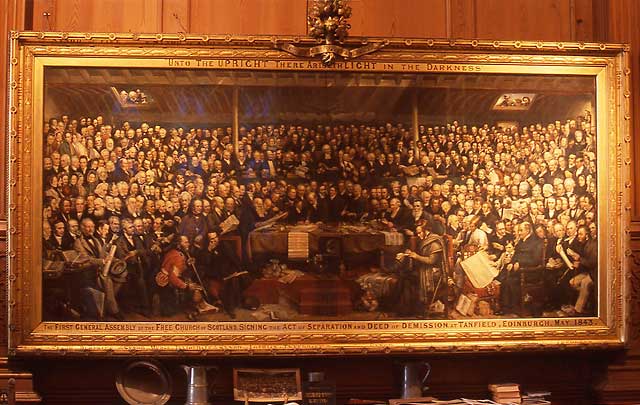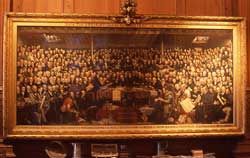Painting by David Octavius Hill RSA |
Reproduced with acknowledgement to the Free Church of Scotland © Photographed by peter.stubbs
The Disruption Painting: Please click here to view three close-up views |
|
The Disruption Painting |
|
The Disruption After many years of dispute within the Church of Scotland, concerning the Church's relationship with the church, and in particular intervention over the appointment of ministers, about one third of the Ministers broke away from the established Church of Scotland in 1843 to create the Free Church of Scotland. This became known as 'The Disruption'. The artist D O David Octavius Hill, a landscape and genre painter wished to mark this event by creating a large oil painting of The Disruption. He entered into partnership with Robert Adamson in 1843 so that together they could produce several hundred calotype photos of individual ministers, to be used for this painting. |
|
The Painting The Disruption painting shows the signing of the Act of Separation and Deed of Demission on 23 May 1843. 1,500 people attended the signing of the Act of Separation. There are 457 figures in the painting, including a few who were not present at the ceremony.
Robert Adamson is included in the picture with his camera. D O
Hill is close behind him writing on his notepad. In the doorway at
the upper right-hand corner is Thomas Annan. Despite the effort, over many years, that went into producing the painting, it is not regarded as a success artistically. The figures to not create a very pleasing or believable composition. Some of the figures are represented as they looked in the early 1840s and others as they looked many years later. There are some examples of 'three-headed' figures, where not enough room was left on the canvas to include all the bodies. [GFCS] D O Hill started his disruption painting in 1843 but did not finish the work until 1865, after some encouragement by his wife who considered it took up too much space in their house. It was 11ft 4ins wide. Hill's wife may well have helped by painting some of the figures herself. [Article found by Roddy Simpson] |
|
Other Calotypes As well as the calotypes of Ministers of the Church of Scotland above, the Hill & Adamson partnership produced many portrait and group calotypes, including documentary photos of the fishwives and fishermen of Newhaven, a small fishing village on the Firth of Forth, about two miles to the north of Edinburgh. |

